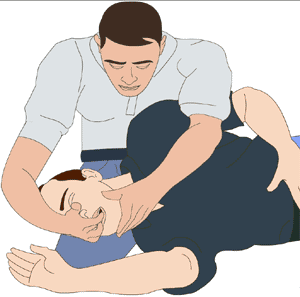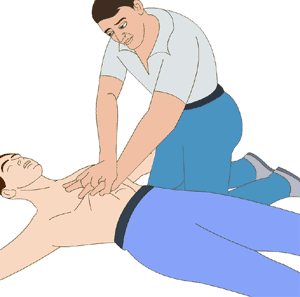|
C - CIRCULATION
Check if the casualty has a pulse.
If casualty has a pulse but is not breathing, start EAR
at 15 breaths per minute.
If no pulse is present immediately start CPR.
How to check pulse?
Feel for a carotid (neck) pulse by placing the pads of
your fingers in the groove beside the Adam's apple or the middle of the
neck on a woman. You can check on either side of the neck. You must check
the pulse for 10 seconds.
Note: When the body is in shock, it often shuts down the
peripheral circulation, including the radial (wrist) pulse. Therefore
it is not advised to check radial pulse.
CARDIO-PULMONARY RESUSCITATION (CPR)
Cardio-pulmonary resuscitation (CPR) is a combination
of the Chest Compression procedure and Expired Air Resuscitation (EAR).
Whichever method is used, the pulse must be checked after
one minute and then at two
minute intervals. Failure to do so may result in brain damage and lead
to death.
Note: CPR must only be practised on a revival dummy.
-
After 5 full breaths, check pulse. If no pulse is present
commence CPR immediately.
-
Position the hands on the Compression point
-
Exert pressure using the heel of the lower hand
-
Depress the Sternum about 4-5 centimetres
-
Give equal time from compression and relaxation
-
Give 15 compressions in 10-12 seconds. 2 breaths in
3-4 seconds. 4 cycles per minute.
CPR for Infants
A child’s bones are not properly formed and more
delicate. There is a critical differences between giving CPR to adults
and children which are as follows:
For children under the age of 1 year:
-
Only use two fingers over the lower half of the breastbone
-
Do not tilt head backwards
-
Jut give small puffs, not full breaths as for adults
-
EAR rate 20 breaths per minute
-
1 breath in 5 seconds
-
Compression depth is one third depth of the chest
For children aged between 1 and 8 years:
-
Use the heel of one hand only
-
Give only half a breath
-
Ratios & Rates are the same as for a 1 year old
child
-
Compression depth is one third depth of the chest
|













